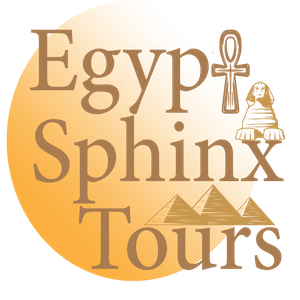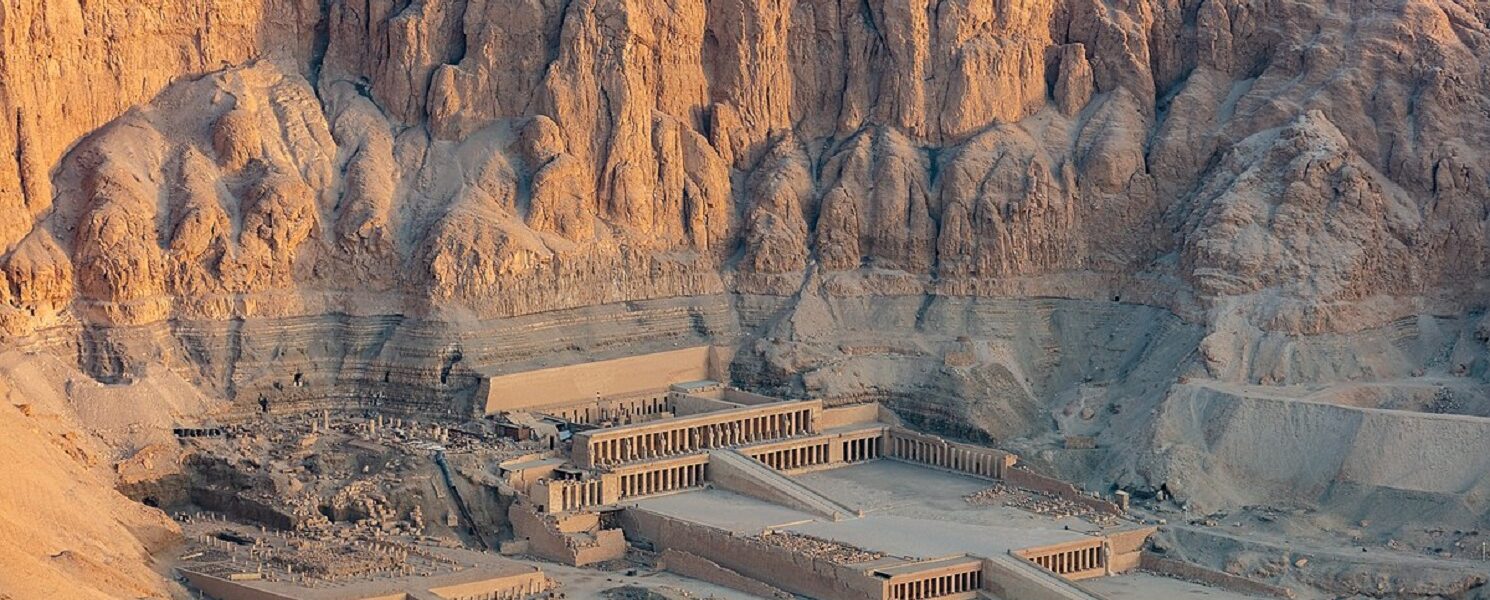The Magnificent Mortuary Temple of Hatshepsut: An Architectural Wonder
The Mortuary Temple of Hatshepsut, known in ancient Egyptian as Ḏsr-ḏsrw, meaning “Holy of Holies,” stands as a testament to the architectural brilliance of ancient Egypt. Constructed during the reign of Pharaoh Hatshepsut of the Eighteenth Dynasty, this temple is located opposite the city of Luxor, in the cliffs of Deir el-Bahari. Renowned as a masterpiece of ancient architecture, the temple’s three massive terraces rise majestically above the desert floor, seamlessly integrating into the surrounding cliffs. This iconic structure served both as a mortuary temple for Hatshepsut and as a sanctuary for the god Amun-Re.
Hatshepsut’s reign marked a period of prosperity and extensive building projects, with the Mortuary Temple being one of her most significant contributions. The temple complex is strategically aligned with her tomb, KV20, which lies within the same massif and is capped by the natural pyramid shape of El Qurn. This alignment reflects the ancient Egyptians’ emphasis on the afterlife and the divine connection between the pharaoh and the gods. The temple’s location at the edge of the desert, connected to an accompanying valley temple by a causeway, underscores its significance in both the physical and spiritual landscapes of ancient Egypt.
Across the Nile River, the temple complex aligns with the monumental Eighth Pylon at the Temple of Karnak, Hatshepsut’s most recognizable addition to Karnak. This alignment was not merely architectural but also ceremonial, as it served as the departure point for the Beautiful Festival of the Valley. During this annual festival, a procession would carry the barque of Amun-Re from Karnak to the Mortuary Temple of Hatshepsut, emphasizing the temple’s role in religious rituals and the rejuvenation of the pharaoh’s divine kingship. This unique dual function of the temple, as both a mortuary and a sanctuary, highlights the intricate planning and symbolic significance embedded in its design.
Architectural Brilliance and Unique Design
The architectural design of the Mortuary Temple of Hatshepsut is unparalleled, showcasing innovative features that distinguish it from other temples of the period. Construction of the temple took place between Hatshepsut’s seventh and twentieth regnal years, during which the building plans were frequently modified to accommodate her evolving vision. Influenced by the adjacent Temple of Mentuhotep II, built six centuries earlier, Hatshepsut’s temple is characterized by its three terraces connected by long ramps, each terrace housing different chambers and sanctuaries.
The temple’s main east-west axis was designed to receive the barque of Amun-Re at the climax of the Beautiful Festival of the Valley. This axis symbolizes the temple’s role in the annual renewal of the pharaoh’s divine kingship. The north-south axis represents the life cycle of the pharaoh, from coronation to rebirth, integrating the solar cult and the mortuary cult within the temple complex. This dual-axis design reflects the ancient Egyptians’ sophisticated understanding of spatial symbolism and their ability to incorporate it into grand architectural projects.
Central to the temple’s unique design is the displacement of the mortuary cult to the south, making way for the sanctuary of the barque of Amun-Re on the main axis. This innovative arrangement underscores Hatshepsut’s devotion to Amun-Re and her strategic use of religious symbolism to legitimize her reign. The middle terrace features shrines to Hathor and Anubis, gods associated with the afterlife and protection, respectively. These shrines are fronted by porticoes adorned with notable reliefs depicting significant events, such as Hatshepsut’s expedition to the Land of Punt and her divine birth. These reliefs not only highlight her accomplishments but also reinforce her divine right to rule.
Iconic Reliefs and Symbolic Artistry
The Mortuary Temple of Hatshepsut is renowned for its exquisite reliefs, which serve both decorative and narrative purposes. Among the most famous are the reliefs depicting Hatshepsut’s expedition to the Land of Punt, a prosperous trading partner located in present-day Somalia or Eritrea. This expedition brought back valuable goods such as incense, myrrh, and exotic animals, symbolizing the prosperity and far-reaching influence of Hatshepsut’s reign. The detailed carvings vividly portray the journey, the foreign landscapes, and the treasures obtained, providing valuable insights into ancient Egyptian trade and diplomacy.
Another significant series of reliefs depicts the divine birth of Hatshepsut, a crucial element in her claim to the throne. According to these reliefs, Hatshepsut was conceived by the god Amun, who took the form of her father, Thutmose I. This divine endorsement was essential for Hatshepsut to legitimize her position as pharaoh, especially as a female ruler in a predominantly male-dominated society. The scenes of her divine birth and subsequent coronation emphasize her unique status and reinforce her authority as a godly progeny.
The temple’s porticoes, particularly on the middle terrace, host these and other notable reliefs that are integral to understanding Hatshepsut’s reign and her strategies for maintaining power. These reliefs are not merely artistic masterpieces but also propaganda tools, crafted to solidify her legacy and communicate her divine right to rule. The intricate carvings, combined with the temple’s architectural grandeur, create a visually stunning and symbolically rich environment that continues to captivate visitors and scholars alike.
Historical Challenges and Preservation Efforts
Despite its grandeur, the Mortuary Temple of Hatshepsut has faced numerous challenges throughout its history. Two decades after Hatshepsut’s death, her successor Thutmose III initiated a campaign to erase her memory, usurping or obliterating references to her rule. This intense yet brief campaign left many of the temple’s reliefs defaced. The reasons behind this proscription remain a subject of debate among historians, with theories ranging from personal grudges to societal opposition to a female pharaoh. The campaign ceased with the enthronement of Amenhotep II, who halted further destruction.
During the Amarna Period, the temple suffered additional damage when Akhenaten ordered the erasure of images of traditional Egyptian gods, particularly Amun, as part of his religious reforms. These damages were later repaired during the reigns of Tutankhamun, Horemheb, and Ramesses II, who restored the temple’s sanctuaries and reliefs. However, an earthquake during the Third Intermediate Period caused further harm, necessitating additional restoration efforts. The temple’s resilience and the repeated attempts to preserve it underscore its enduring significance in Egyptian history.
Visitor Experience and Practical Information
(continued)
are designed to enhance your understanding of ancient Egypt’s cultural and architectural achievements, making your visit both educational and memorable.
When visiting the Mortuary Temple of Hatshepsut, it’s essential to respect the site’s historical and cultural significance. Follow the guidelines provided by the authorities, such as refraining from touching or climbing on the ancient structures, to help preserve this incredible heritage for future generations. The temple complex is expansive, so wearing comfortable shoes and bringing water is advisable. Additionally, the visitor center provides informative exhibits that offer context and background before you explore the temple itself.
The site is well-equipped with amenities, including restrooms and shaded areas, allowing visitors to take breaks and absorb the stunning surroundings at their own pace. For those interested in photography, the interplay of light and shadow on the temple’s terraces and reliefs provides ample opportunities for capturing breathtaking images. Whether you’re a history enthusiast, an archaeology buff, or simply a curious traveler, the Mortuary Temple of Hatshepsut offers a captivating glimpse into the grandeur of ancient Egyptian civilization.
The Cultural and Religious Significance of Hatshepsut’s Temple
The Mortuary Temple of Hatshepsut is not only a testament to architectural ingenuity but also a site of profound cultural and religious importance. Hatshepsut’s reign was marked by her efforts to assert her legitimacy as a female pharaoh, and the temple played a crucial role in these endeavors. The temple’s design and reliefs were strategically crafted to emphasize her divine birth and her rightful place on the throne, reinforcing her authority and divine mandate.
Central to the temple’s religious significance is its connection to the god Amun-Re. The temple’s main axis was designed to align with the path of the sun, symbolizing the journey of Amun-Re across the sky. This alignment highlights the temple’s role in the worship of Amun-Re and its participation in the annual Beautiful Festival of the Valley. During this festival, the barque of Amun-Re was carried from the Temple of Karnak to Hatshepsut’s temple, where rituals and offerings were performed to ensure the continued prosperity and stability of the pharaoh’s reign.
The temple also features shrines dedicated to other deities, such as Hathor and Anubis, underscoring its multifaceted religious function. Hathor, the goddess of love and motherhood, and Anubis, the god of mummification and the afterlife, were both integral to the temple’s spiritual landscape. These shrines, located on the middle terrace, hosted important rituals and were adorned with elaborate reliefs that illustrated the temple’s religious activities. The inclusion of these deities reflects the comprehensive nature of Hatshepsut’s religious program and her efforts to integrate various aspects of Egyptian spirituality into her mortuary complex.

